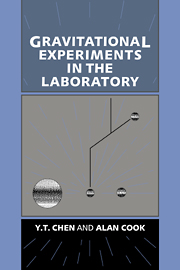Book contents
- Frontmatter
- Contents
- Preface
- 1 Introduction
- 2 The linear oscillator driven by thermal noise and with electrical damping
- 3 External sources of noise and design of experiments
- 4 The weak principle of equivalence
- 5 Verification of the weak principle of equivalence for free particles
- 6 Newtonian attractions of extended bodies
- 7 Experimental tests of the inverse square law
- 8 The constant of gravitation
- 9 Conclusion
- References
- Index
6 - Newtonian attractions of extended bodies
Published online by Cambridge University Press: 10 October 2009
- Frontmatter
- Contents
- Preface
- 1 Introduction
- 2 The linear oscillator driven by thermal noise and with electrical damping
- 3 External sources of noise and design of experiments
- 4 The weak principle of equivalence
- 5 Verification of the weak principle of equivalence for free particles
- 6 Newtonian attractions of extended bodies
- 7 Experimental tests of the inverse square law
- 8 The constant of gravitation
- 9 Conclusion
- References
- Index
Summary
Introduction
In tests of the weak principle of equivalence, exact calculations of the attractions of masses are not necessary, but they are essential in experiments to test the inverse square law and to measure the gravitational constant. In fact, the calculation of the gravitational attraction of laboratory masses is usually not at all simple, because the dimensions of the masses are comparable with the separations between them, so that neither the test mass nor the attracting mass can be treated as a point object. In the following sections we discuss the gravitational attractions of laboratory masses with various common geometrical shapes. We present the results in terms of the gravitational efficiency, that is, the ratio of the gravitational attraction of a laboratory mass at a certain separation to that of a point mass with the same mass and separation. Furthermore, the precision demanded in measurements of separations of masses, the most difficult measurements in the determination of G and the test of gravitational law, depends on the geometry of the masses. These effects can have a strong influence on the conduct and final results of an experiment and it is essential to discuss in detail the calculation of potentials and attractions before going on to describe experiments.
Masses of three forms are often used in the laboratory: spheres, cylinders and rectangular prisms. The formula for the gravitational attraction of a sphere is well known and simple, but in practice it is not possible to manufacture an ideal sphere, the practical problem is usually how the real precision of manufacture affects the results; cylinders and prisms can be made very precisely but calculating the attraction is difficult.
- Type
- Chapter
- Information
- Gravitational Experiments in the Laboratory , pp. 109 - 133Publisher: Cambridge University PressPrint publication year: 1993



